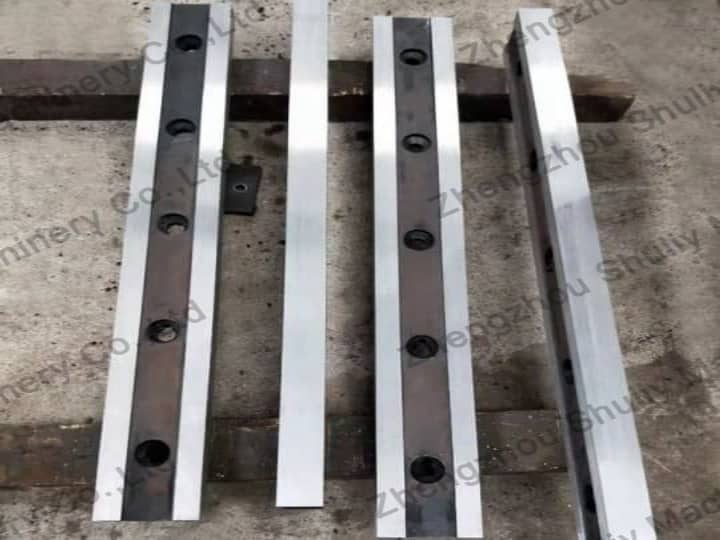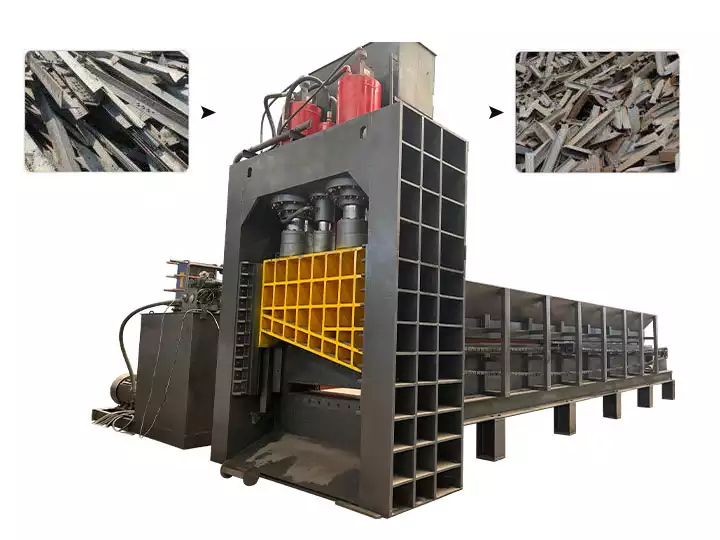Πώς να επιλέξετε και να εγκαταστήσετε λεπίδες διάτμησης αλιγάτορα;
Υδραυλική διάτμηση μετάλλωνχρησιμοποιούνται ευρέως στην ψυχρή διάτμηση των απορριμμάτων χάλυβα. Η διάτμηση μετάλλων είναι κατάλληλη για διάφορα ακατέργαστα υλικά μετάλλων, όπως στρογγυλό χάλυβα, τετράγωνο χάλυβα, χάλυβα γωνίας, χάλυβα πλάκας, χαλύβδινο σωλήνα, ενίσχυση απορριμμάτων, μικρό μπλοκ συμπίεσης, χαλύβδινη πλάκα κ.λπ. Λόγω της απλής δομής σχεδίασής του, του χαμηλού ποσοστού αστοχίας, του υψηλού πίεση διάτμησης, χαμηλό κόστος συντήρησης, μεγάλη διάρκεια ζωής, η υδραυλική μηχανή κοπής μετάλλων είναι ένα ιδανικό προϊόν στη μεταλλουργική βιομηχανία. Είναι γνωστό ότι το υλικό των λεπίδων διάτμησης αλιγάτορα είναι το κλειδί για την απόδοση της λεπίδας, αλλά και ο πυρήνας του εξοπλισμού. Η μηχανή κοπής παλιοσίδερων μπορεί να ικανοποιήσει τις αυστηρές απαιτήσεις για το τμήμα φινιρίσματος της πλάκας. Η κοπή του προς κοπή υλικού είναι επίπεδη και λεία, χωρίς γρέζια. Αυτό το άρθρο παρουσιάζει κυρίως τους τύπους λεπίδων και τις εγκαταστάσεις που ενδιαφέρουν τους χρήστες.
Πρέπει οι λεπίδες διάτμησης αλιγάτορα να είναι όσο το δυνατόν πιο σκληρές;
Το κύριο αντικείμενο κοπής των λεπίδων είναι όλα τα είδη σκληρών μεταλλικών υλικών, επομένως η σκληρότητα της λεπίδας πρέπει να είναι επαρκής. Επιπλέον, η αντοχή στη φθορά των λεπίδων διάτμησης αλιγάτορα είναι επίσης σημαντική επειδή χρησιμοποιούνται συχνά. Η σκληρότητα και η αντοχή στη φθορά της λεπίδας διάτμησης εξαρτάται κυρίως από τη θερμική επεξεργασία στη διαδικασία μηχανικής κατεργασίας. Κατά την κοπή της πλάκας σιδήρου, όσο μεγαλύτερη είναι η σκληρότητα της λεπίδας, τόσο πιο ανθεκτική στη φθορά είναι. Ωστόσο, θα πρέπει να σημειωθεί ότι η πολύ υψηλή σκληρότητα μπορεί να οδηγήσει σε εύθραυστη άκρη της λεπίδας και η θραύση της λεπίδας είναι εύκολο να συμβεί όταν διατμείται πολύ υψηλή σκληρότητα ή παχιά πλάκα σιδήρου. Επομένως, η θερμική επεξεργασία της λεπίδας διάτμησης είναι το κλειδί για τον προσδιορισμό της σκληρότητας και επίσης επηρεάζει άμεσα την απόδοση της λεπίδας.
Οι τύποι λεπίδων μηχανών διάτμησης αλιγάτορα

Το τυπικό υλικό των λεπίδων διάτμησης αλιγάτορα είναι 9CrSi και άλλα υλικά περιλαμβάνουν γενικά T10, 6CrW2Si, Cr12MoV, H13, κράμα χάλυβα κ.λπ.
1. Για χάλυβα εργαλείων χαμηλού κράματος: το συνήθως χρησιμοποιούμενο υλικό της λεπίδας είναι 9CrSi, κ.λπ., και η σκληρότητα της θερμικής επεξεργασίας της λεπίδας είναι εντός της περιοχής HRC58-62 μοίρες. Χρησιμοποιείται ειδικά για την κοπή ανοξείδωτου χάλυβα, ο οποίος είναι κατάλληλος για την κοπή πλακών θερμής έλασης, ανοξείδωτου χάλυβα, μεσαίων και παχιών πλακών.
2. Ο χάλυβας εργαλείων συνδεδεμένος με άνθρακα υιοθετεί γενικά χάλυβα 65, 75, T8, T10 και άλλα υλικά. Η σκληρότητα της θερμικής επεξεργασίας της λεπίδας που παράγεται από αυτό το υλικό είναι εντός της περιοχής hrc57-59 μοίρες. Είναι κατάλληλο για την ανακύκλωση και το κούρεμα συνηθισμένων πλακών ψυχρής έλασης χαμηλών εκπομπών άνθρακα, συνηθισμένων πλακών Α3 και απορριμμάτων. Αυτό το χαρακτηριστικό είναι χαμηλό κόστος και κατάλληλη τιμή προϊόντος.
3. Για κράμα χάλυβα εργαλείων, το υλικό λεπίδας της διάτμησης πλάκας μπορεί να είναι 4Cr5MoSiV1 (h13k), H13, κ.λπ. Η λεπίδα αυτού του υλικού χρησιμοποιείται για μπιγιέτα θερμής έλασης, μέσο θερμής διάτμησης και παχιά χαλύβδινη πλάκα, η οποία χαρακτηρίζεται από υψηλή -αντοχή στη θερμοκρασία και δύσκολη ανόπτηση.
Προδιαγραφές λεπίδων: Οι τυπικές λεπίδες διατίθενται από το απόθεμα και τα μη τυποποιημένα εργαλεία κοπής μπορούν να προσαρμοστούν σύμφωνα με συγκεκριμένες απαιτήσεις.
Πώς να εγκαταστήσετε τις λεπίδες της υδραυλικής μηχανής κοπής αλιγάτορα;

Τα βήματα εγκατάστασης των λεπίδων διάτμησης αλιγάτορα
- Καθαρίστε και μετρήστε
Καθαρίστε προσεκτικά την περιοχή κλειδώματος και τοποθετήστε το εργαλείο κοπής στον πυργίσκο. Στη συνέχεια, μετρήστε την απόκλιση των μεταλλικών λεπίδων διάτμησης στη διαδρομή με μήκος 100 mm, το οποίο δεν πρέπει να υπερβαίνει το 1 mm.
- Ελέγξτε την κατακόρυφη κατάσταση
Γενικά, η μέθοδος για τον εντοπισμό του εάν η λεπίδα της μηχανής κοπής παλιοσίδερων είναι κατακόρυφη είναι ο έλεγχος των παραγόμενων τσιπ. Εάν το τσιπ που παράγεται από το τεμάχιο εργασίας ρέει προς τη μία πλευρά με τη μορφή μακριών νημάτων, ενδέχεται η λεπίδα ψαλίδας κροκόδειλου να έχει τοποθετηθεί λανθασμένα. Ένα άλλο φαινόμενο είναι η πρόωρη φθορά στο φιλέτο της λεπίδας κοπής. Δείχνει ότι η μία πλευρά της λεπίδας είναι υπό μεγαλύτερη πίεση από την άλλη πλευρά.
- Ελέγξτε την κατάσταση κοπής
Κατά την εγκατάσταση, μια ελαφρά σύγκρουση θα προκαλέσει επίσης απόκλιση. Επομένως, ελέγξτε τις συνθήκες κοπής του εργαλείου κοπής το συντομότερο δυνατό μετά την εγκατάσταση, κάτι που μπορεί να βοηθήσει στον εντοπισμό και την αποφυγή σοβαρής βλάβης της λεπίδας διάτμησης μετάλλων.
- Επιθεωρήστε τη σχετική θέση
Ένα άλλο σημαντικό στοιχείο είναι η θέση της κοπτικής ακμής σε σχέση με τον άξονα του τεμαχίου εργασίας. Μεταξύ αυτών, συνήθη προβλήματα είναι η πρόωρη φθορά και η ξαφνική αστοχία, η κακή μορφή τσιπ, η κακή τραχύτητα της πλευράς και οι κραδασμοί.
- Παρατηρήστε το ύψος των λεπίδων διάτμησης αλιγάτορα
Όταν η λεπίδα είναι εγκατεστημένη ελαφρώς πάνω από το κέντρο, η εφαπτομενική δύναμη μπορεί να δράσει σε μεγαλύτερη περιοχή της λεπίδας. Αυτό θα αυξήσει την αντοχή της λεπίδας κοπής και θα τοποθετήσει τις λεπίδες σταθερά στην υποδοχή.







